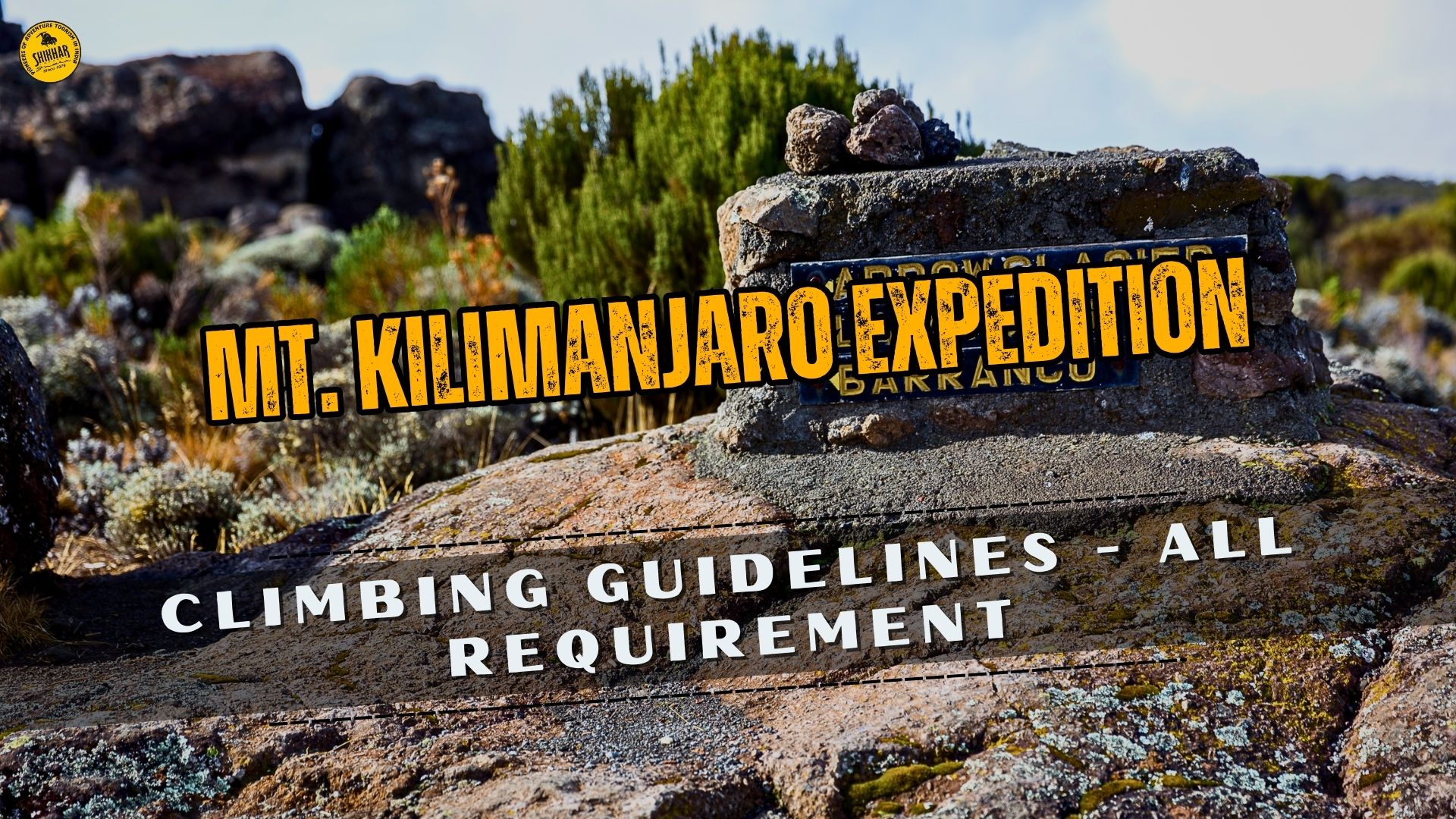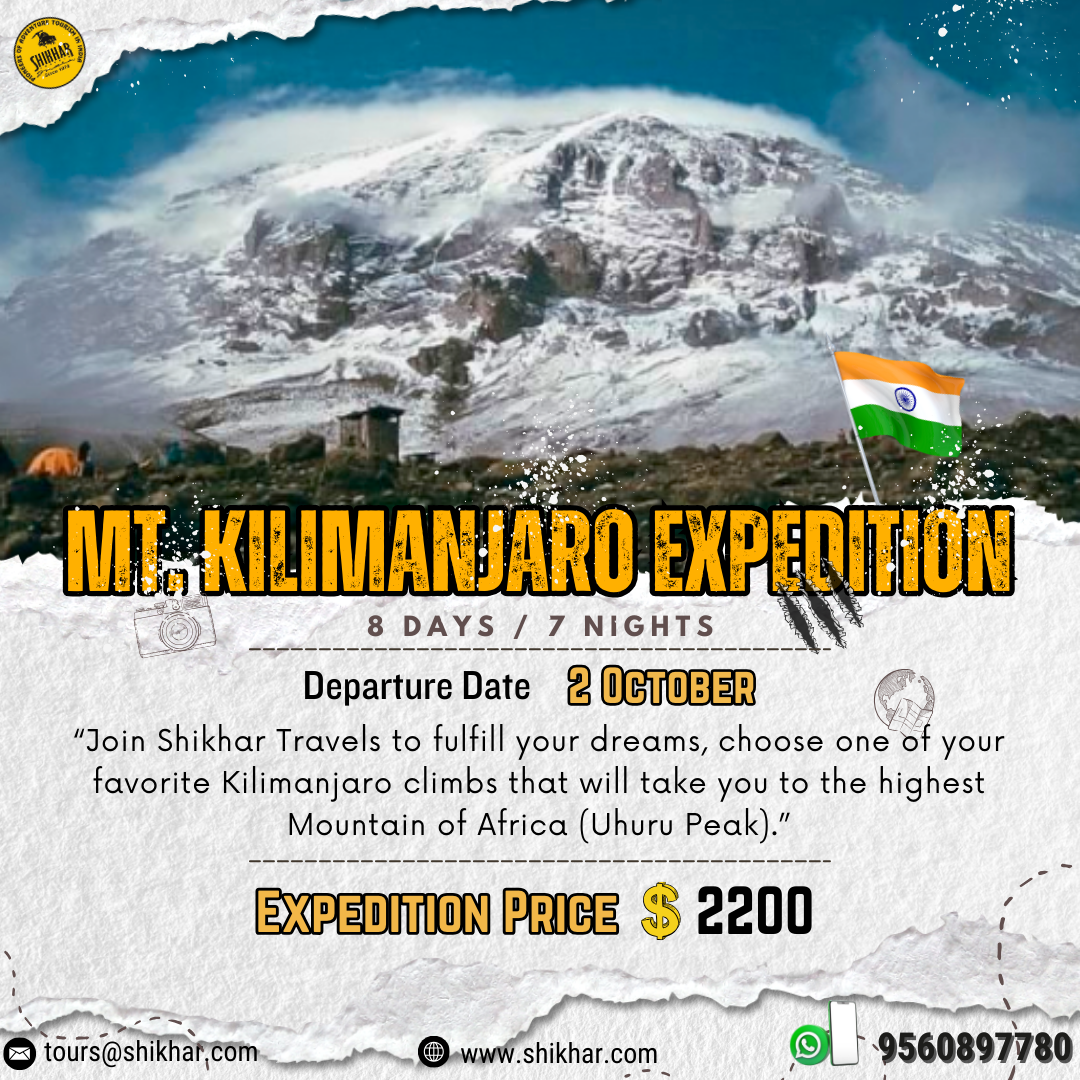Mount Kilimanjaro Climbing Guidelines – All Requirement
Are you ready to Climb Africa’s highest peak, Mount Kilimanjaro?

Join us on an amazing trekking to Africa’s Summit. This blog will offer you with all of the necessary information for a successful climb to Mt. Kilimanjaro.
Link:- Mount Kilimanjaro
Best Time to Climb Mount Kilimanjaro?
Choosing the best time to climb Kilimanjaro is important to a successful expedition. The best time to climb is during the dry season, which is divided into two different seasons:
1. January to March (Late-Mid Monsoon Season): With less crowds, clear sky, and beautiful environment, this is excellent time to climb Mount Kilimanjaro.
2. June to October (Long Dry Season): This time of year has the most beautiful weather, with warm days and cool nights. It’s peak climbing season, so expect an extra crowd.
Itinerary for Mount Kilimanjaro
We provide detailed information on routes, itineraries, safety, and more.
Check here Our Upcoming Expedition Date:- Mount Kilimanjaro
Weather on Kilimanjaro
The weather on Mount Kilimanjaro can be unpredictable. While temperatures are relatively normal on the lower slopes, temperatures decrease dramatically as you climb Mt Kilimanjaro.
Note: Be prepared for Cold Weather
Mount Kilimanjaro Climb Route Options
There are many routes to the summit of Kilimanjaro, each with its own unique experience. Most Popular Route Mention Below
- Machame Route: Known for its stunning scenery and gradual acclimatization.
- Marangu Route: Also called the “Coca-Cola” route, known for its hut accommodations.
- Lemosho Route: Offers a longer, more gradual ascent and a high success rate.
- Rongai Route: Known for its remote wilderness and less crowded trails.
- Northern Circuit Route: The longest route with the highest success rate, ideal for acclimatization.
How to Reach Kilimanjaro
Fly into Kilimanjaro International Airport and where our team waiting for you. We suggest arriving at least one day before your expedition date.
Insurance Options
Travel insurance is mandatory. Make sure that your policy covers high-altitude trekking and possible evacuation. We can help you choose the correct insurance for your Mount Kilimanjaro Expeditions.
Visa Process
Most visitors to Tanzania need a visa. A tourist visa can be obtained on arrival at JRO or in advance through the Tanzanian embassy or consulate in your native country.
What to Carry – Gear List
Packing the right equipment is important for a comfortable and safe trek to Mount Kilimanjaro. Here’s a basic gear list:
– Clothing: Layering is key. Pack moisture-wicking base layers, insulated mid-layers, and a waterproof jacket. Don’t forget gloves, a beanie, and a good-quality down jacket.
– Footwear: Sturdy, waterproof hiking boots with good ankle support are a must. Bring moisture-wicking socks and gaiters for added protection.
– Headlamp: A reliable headlamp with extra batteries for early morning summit attempts.
– Backpack: A comfortable daypack for essentials like water, snacks, and extra clothing layers.
– Sleeping Bag: A high-quality, cold-rated sleeping bag for the colder nights at higher altitudes.
– Trekking Poles: These provide stability and reduce strain on your knees during descents.
– Sun Protection: Sunglasses, sunscreen, and a wide-brimmed hat to shield yourself from the sun’s rays.
– First Aid Kit: Basic medical supplies, blister treatment, and any personal medications.
Jungle Safari Options After Mount Kilimanjaro Climb (1/2 Days)
After climbing Mount Kilimanjaro, you can go on an exciting jungle safari to discover Tanzania’s wildlife and natural beauty. Here are some short safari adventures option:
1. Arusha National Park:
– This park is easily accessible and offers a wide range of wildlife and landscapes. It is located near Arusha town.
– Highlights include the Ngurdoto Crater, Momela Lakes, and lush forests inhabited by colobus monkeys.
– You can go for a game drive, take a walking safari, or enjoy a canoeing experience on one of the Momela Lakes.
2. Tarangire National Park (1-Day Safari):
– Known for its massive baobab trees and large herds of elephants, Tarangire is a short drive from Arusha.
– The park is also home to various other wildlife, including lions, leopards, zebras, and giraffes.
– A one-day safari allows you to witness the beauty and wildlife of Tarangire without an extended time commitment.
3. Lake Manyara National Park (1-Day Safari):
– This compact park is famous for its tree-climbing lions and diverse birdlife along the shores of Lake Manyara.
– Enjoy game drives and explore the park’s unique terrain in a single day.
4. Ngorongoro Crater (1-Day Safari):
– Often referred to as the “African Eden,” the Ngorongoro Crater is a UNESCO World Heritage Site.
– It offers an incredible concentration of wildlife, including the Big Five (lion, leopard, elephant, buffalo, and rhinoceros).
– A day trip to the crater provides an opportunity to witness this natural wonder.
5. Lake Duluti Canoeing (Half-Day):
– For a unique experience, you can go canoeing on Lake Duluti, situated near Arusha.
– Enjoy the tranquility of the lake, surrounded by lush greenery and birdlife.
6. Coffee Plantation Tours:
– Tanzania is renowned for its coffee, and you can take a guided tour of a local coffee plantation.
– Learn about the coffee-making process and sample freshly brewed coffee.
7. Cultural Tours:
– Explore the rich culture of Tanzania by visiting local Maasai villages or engaging in cultural experiences.
– Learn about traditional customs, dance, and interact with the local community.
These short safari option are ideal for those, having limited time after climbing Mount Kilimanjaro. Choose safari as per your interests and experience a one-of-a-kind and unforgettable post-trek journey in Tanzania’s gorgeous landscapes and wildlife.
Other Alternative Climbing Options in the Seven Summits
If you mountaineer, consider taking on the Seven Summits challenge, which involves climbing the highest peak on each continent. Kilimanjaro, one of the Seven Summits, is an excellent starting place. Our professional and Experienced guides can advise you on how to accomplish seven summit.
If you’re pursuing the Seven Summits challenge but want alternatives to Mount Kilimanjaro, here are some exciting options:
1. Asia: Mount Everest, Nepal/Tibet – The tallest mountain in the world and the ultimate challenge for climbers.
Check Expedition Date, Price, etc.:-https://www.shikhar.com/mt-
2. South America: Aconcagua, Argentina – The highest peak in South America, known for its challenging high-altitude conditions.
Check Expedition Date, Price, etc.:-https://www.shikhar.com/
3. North America: Denali, USA – North America’s highest peak, renowned for its extreme cold and unpredictable weather.
Check Expedition Date, Price, etc.:-https://www.shikhar.com/
4. Europe: Mount Elbrus, Russia – The highest mountain in Europe, offering a unique cultural and mountaineering experience.
Check Expedition Date, Price, etc.:-https://www.shikhar.com/mt-
5. Antarctica: Mount Vinson – The highest peak in Antarctica, located in one of the most remote and pristine environments on Earth.
Check Expedition Date, Price, etc.:- https://www.shikhar.com/
6. Australia/Oceania: Puncak Jaya (Carstensz Pyramid), Indonesia – The tallest peak in Oceania, known for its challenging rock climbing.
Check Expedition Date, Price, etc.:-https://www.shikhar.com/
7. Africa: Mount Kilimanjaro, Tanzania – Although you’re considering alternatives, it’s important to note that Mount Kilimanjaro is traditionally included in the Seven Summits as the highest peak in Africa.
Check Expedition Date, Price, etc.:- https://www.shikhar.com/mount-kilimanjaro-trekking-5895-m-sti673
The Seven Summits challenge is represented by these peaks, and each one provides a unique and challenging climbing experience. we are welcoming to who want join us for Mount Kilimanjaro Expedition, is the most well-known option for Africa in the Seven Summits challenge.
Frequently Asked Questions
1. Where is Mount Kilimanjaro located?
Ans. Mount Kilimanjaro is located in Tanzania, East Africa.
2. Mount Kilimanjaro height?
Ans. Mount Kilimanjaro height – 5,895 meters (19,341 feet).
3. Do I need previous climbing experience to trek Kilimanjaro?
Ans. No prior climbing experience is required
4. How long does it take to climb Kilimanjaro?
Ans. The duration to climb Mt. Kilimanjaro 6 to 9 days [varies by route]
5. Do I need a permit to climb Kilimanjaro?
Ans. Yes, you need permits for both the park entrance and camping fees.
6. What’s the best time to climb Kilimanjaro?
Ans. The dry seasons from January to March and June to October are ideal.
7. Do I need travel insurance for Kilimanjaro?
Ans. Yes, travel insurance that covers high-altitude trekking and emergencies is essential.
8. What is the cost of climbing Kilimanjaro?
Ans. ( Our Cost 2200 US dollar ) for Limited Period. The cost varies depending on the route, tour operator, and services included. Budget for permits, guides, gear, and accommodations.
9. What type of gear and clothing do I need?
Ans. You’ll need layers of clothing, a good-quality sleeping bag, waterproof boots, and essential trekking gear.
A Mount Kilimanjaro expedition with Shikhar Travels is a once-in-a-lifetime opportunity. We are committed to guaranteeing your safety, comfort, and the best trekking experience possible. Contact us today to begin your journey to Africa’s Roof!



Pingback: Mount Vinson Massif Guide - Mountain in the Antarctic